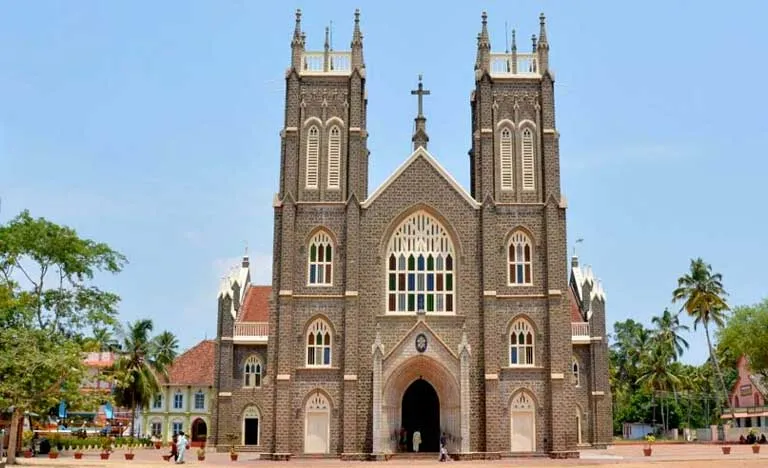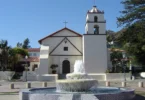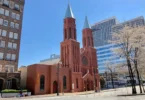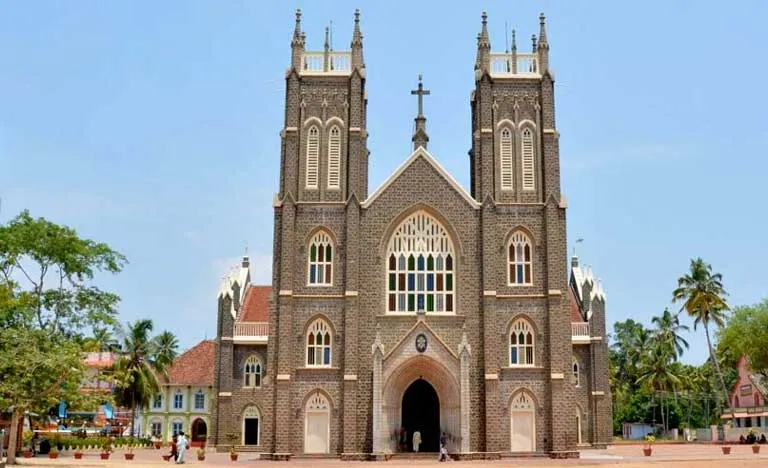
Introduction
Saint Andrew’s Basilica, Arthunkal, Alleppey, Kerala, India is one of the famous pilgrim centres in South India. The largest shrine of St Sebastian in the world, the church known as Arthunkal St. Andrew’s Basilica and St. Sebastian’s International Shrine in Arthunkal, Cherthala, Alappuzha district, Kerala, India, was constructed by waning just Portuguese missionaries in the 16th century. The grand annual feast of St Sebastian Arthunkal in January, which lasts for a month accompanied by millions of pilgrims is one of the important celebrations and major attractions in India.
Though the Church is named after St. Andrew the Apostle, it is the feast of St. Sebastian that has brought fame to Arthunkal. The Christian presence in Arthunkal dates back to a very early period, to 7th Century or earlier. After the arrival of the Portuguese in Kerala Jesuit missionaries turned their attention to Arthunkal. They under-took missionary work in Arthunkal from 1530 onwards. As there was a ban on Christian conversion till 1560 permission to put up churches was hard to obtain. When Fr. Gasper Pious s was appointed the first Vicar of Arthunkal he managed to get permission to construct a Church.
In 1581 the King of Cochin, Veera Kerala Varma, gave permission to build a Church in wood. It was the second Vicar, Fr. Giacomo Fenicio S.J. who managed to obtain permission from the King to renovate the wooden church in stone in 1602. He had spent 33 years in Arthunkal in two terms and is rightfully called the Apostle of Arthunkal.
Arthunkal rose to fame when in 1647 the miraculous statue of St. Sebastian was brought to Arthunkal from Italy in a ship. St. Sebastian was the captain of the body guards of the Roman Emperor Diocletian. He was brutally killed and became a martyr in 286 AD on account of his faith in Christ.
People from all beliefs who were afflicted by epidemics prayed to St. Sebastian and were cured. And the feast of St. Sebastian in January began to attract thousands of people from every walk of life. Gradually Arthunkal became a pilgrim centre for people of all creeds. In 18th century the basilica was taken charge by Carmelite missionaries from Jesuit missionaries. During the Carmelite period on 29th November 1829 St. Chavara Kuriakose Elias was ordained by Rt. Rev. Dr. Mauralius Stablini, the Archbishop of Verapoly who was residing at Arthunkal Basilica.
Saint Andrew’s Basilica, Arthunkal built in stone in 1602 was renovated again in 1870 with a new facade and a bell tower. The new Church in granite (nibbles), the foundation of which was laid shortly after 1900, was blessed and opened for service in 1967. It took 60 years to complete the new Church. There is an ancient tradition followed to this day by the devotees of the Hindu deity, Lord Ayyappa, that they pay homage to St. Sebastian as they return from Sabarimala, the abode of Lord Ayyappa.
Every year from January 10 to 27 the feast of St. Sebastian takes place at Saint Andrew’s Basilica, Arthunkal attracting lakhs of people. The procession with the statue of St.Sebastian on 20th January is the main attraction of the feast. During the procession eagles hover over the statue of St. Sebastian recalling how the wounded St. Sebastian was taken care by eagles. An ocean of people moves with the statue of St.Sebastian during the precession. Considering the antiquity and the fame of the Church, the Holy See after due process, has granted Basilica status to St. Andrew’s Church, Arthunkal on 21St May 2010.
The historic honour bestowed upon this church was solemnly declared on 11 the October 2010 during a Pontifical Mass presided over by His Grace Most Rev. Dr. Salvatore Pennacchio, the Apostolic Nuncio to India. A great drawback of Arthunkal Basilica was the unsuitable sanctuary which was totally unfitting to its external majestic look. As per the records found in the archives of the Parish an extraordinarily beautiful and elegant altar was planned by forefathers. But it could not be realized might be because of the financial strain.
In 2016 immediately after the feast of St. Sebastian the church was closed for its renovation. H.E. Bp. Stephen Athipozhiyil, his coworkers in the Bishop’s house and the Basilica committee showed green flag to proposal of Fr. Christopher M. Arthasseril the Parish Priest and Rector of St. Andrew’s Basilica to construct the sanctuary and to do whatever is possible to avoid grave acoustic problems in the church. Hectic preparation and efforts were made to complete the reconstruction and beautification of the church within one year and definitely before the Makaram Thirunal 2017.
The reconstruction of the sanctuary was entrusted to Mr. Amal Francis from Pizhala, Ernakulam District who was such a young man in his late twenties. The wooden paneling and the interior decoration including the wooden fencing of the sanctuary was entrusted to Mr. Jose Kurisinkal a parishnior of Arthunkal Basilica.
By God’s grace and mercy the works could be miraculously completed taking only eleven months and the church was blessed and opened on 8th January 2017. H.E Rt. Rev. Dr. Stephen Athipozhiyil blessed the new sanctuary while the congregation assembled in and outside the church chanting the heavenly hymns of gratitude to heavenly Father who feeds even the little sparrow. It was a memorable day. Dr. James Anaparambil was the homilist on that wonderful day and the homily was inspiring and biblical and the same is being remembered even today.
The new altar in the sanctuary which depicts the last supper is a big attraction of St.Andrew’s Basilica. It was constructed by Mr. Raphy from Mudamvely a talented carpenter who is well known in Ernakulam and Alleppey district. The altar made of teak wood is so glorious and majestic and one of the biggest altars found in Kerala Church.
The new sanctuary of Arthunkal Basilica is the biggest attraction of all the pilgrims from Kerala and outside Kerala. The most important thing is, it really gives every prayerful atmosphere in the church and people spend even hours inside the church. It was also the decision of the parish priest that the church should provide enough seating arrangements in the church and the pews made of the teak wood was constructed in view of that.
It was a great fortune to Arthunkal Basilica to have the Episcopal Ordination of H.E Bishop James Raphel Anaparambil at St. Andrew’s Basilica, Arthunkal on 11th February 2018.The historical event of ordaining a Bishop which is usually done at the Cathedral Church fortunately happened at St. Andrew’s Basilica, which situated in the middle part of diocese of Alleppey. It was the desire and decision solely of Bishop James Raphel Anaprambil who was entrusted the appointment order as the Co-adjutor Bishop of the diocese of Alleppey.
By the Nuncio Arch Bishop Giambattista Diquattro calling him at the nunciature office in Delhi on 30th November, the feast day of St. Andrew, the apostle. The Episcopal Ordination ceremony itself was a noticeable event by the presence of forty Bishops from 3 Rites. The Church, church compound and its vicinities were fully packed by the faithful. All the functions including the reception and felicitatory meeting were well arranged and were notable by the presence of huge congregation.
The Rosary Park in the compound is also a big attraction to the devotees and pilgrims. All the twenty mysteries – major Christ events described in the Gospel are depicted beautifully and wonderfully. Each and every statue in the Rosary Park reminds us of the medieval sculptural work in Europe. The works were done by Mr. Amal Francis, the same artist who constructed the sanctuary of Saint Andrew’s Basilica, Arthunkal.
The Rosary Park was blessed by Bishop Stephen Athipozhiyil in the presence of Bishop James Raphel Anaparambil and Bishop Douglas Regattieri, Diocese of Cesena, Italy just before the flag hoisting for the feast of St. Sebastian on Thursday 10th January 2019. May St. Sebastian, the courageous witness of the- gospel of life and love in Christ, be the special protector of all who seek his intercession!
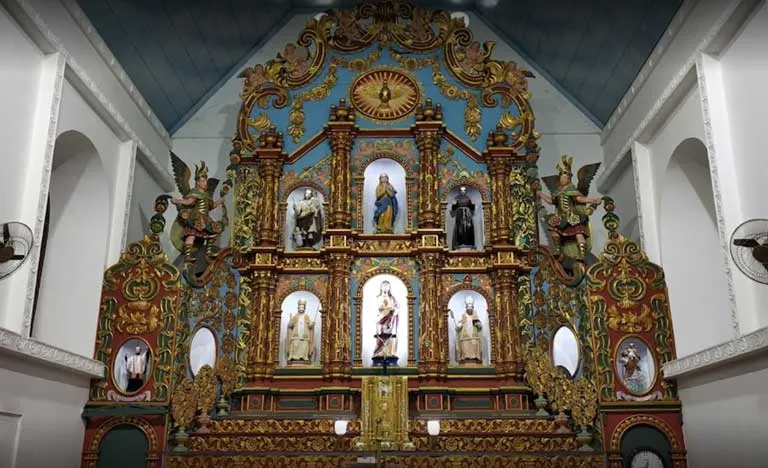
History of Saint Andrew's Basilica, Arthunkal
Arthunkal was the capital of Muthedath Kingdom, one of the pricipalities of Kerala, during the 16th century. Historians opine differently as to how Arthunkal got that name.
One among them is that it has evolved from ‘Arthikulangara’, the name of the place at that time. Arthikulangara, in course of time turned ‘Arthikulangal’ and later on, Arthunkal.
According to historian George Schurhammer, the capital of Muthedath was known as ‘Muthedathunkal’ (at Muthedath) and it changed to ‘Edathunkal’ and then Arthunkal. Portuguese Missionaries landed in Kerala following the arrival of Vasco da Gamma. They visited Muthedath and found so many St Thomas Christians here. They were not baptized, but their ancestors were. The Jesuit missionaries started their mission in Muthedath and Elayedath(the neighbouring principality). In 1579 A.D., the Jesuit priest Manuel Texeira from Goa visited Arthunkal on his way from Kochi to Kollam (Quilon). As on request by the Christians, he arranged Fr Gasper Pius to be appointed in Arthunkal for their spritual services in 1581.
Since 1560 A.D., the Christians and missionaries had been requesting the Muthedath King for the permission of an oratory, though the king did not give much attention to. But following the incessant pestering from the Christians and considering the helps the king had from the missionaries, he granted permission in November, 1581 to construct a church using wood and coconut leaves. He also granted a few trees from his premises for the purpose.
The Christians installed a wooden cross and constructed, with the co-operation of the local Hindus, a church, where the king had given permission to. On 30th November, the church was consecrated in the name of St Andrew the Apostle. The first vicar was Fr Gasper Pius S.J. On completion, the king of Muthedath came to visit the church and asked the vicar to maintain the church suitably to be the House of God. Since then, many Hindus from the neighboring regions came to the church, prayed to St Andrew and got their appeals fulfilled.
In November, 1582, Fr Gasper Pius died of exessive hardwork, hot climate and malnutrition. Another Jesuit priest took charge of the church, but stayed in Kochi. On 30th November, 1583, on the feast day of St Andrew, 500 St Thomas Christians were baptized. They were later known as ‘Anjootikkar’ (The Five Hundred People). A nair knigt with his 20 soldiers embraced Christianity on the same day, in presence of the King of Muthedath.
In 1584 A.D., Fr Jacomo Fenicio S.J. was appointed vicar of Arthunkal. He started the construction of a new church in stone and lime, with permission of the King, and completed it in 7 years. After Fr Fenicio was transferred to Kozhikode, eight priests took charge in succession. Fr Fenicio was appointed again in 1619, and in the next year, he reconstructed the church. He was much loved and was considered a holy man by the people and the administrators. People called him saint and ‘Veluthachan’, meaning white father. ‘Veluthachan’ later became the popular name of St Sebastian.
Fr Fenicio said to have performed lots of miracles while he was still alive. Even Hindus believed in the power of his prayers and approached him for his blessings. He was known as the second Apostle of the east and died in 1632. Huge was the crowd including kings flowed in, to pay him the final tribute. His body was buried inside the church and people used to pray and light candles there. The tomb is still preserved near the altar of the old church.
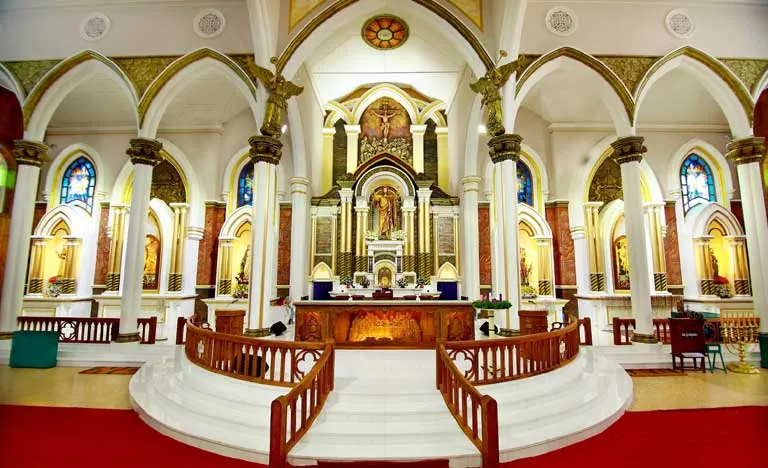
Fr Fonsaco, who took charge after Fr Fenicio, reconstructed the church in 1640 with the elevation facing west. It is during his time, that the Miraculous statue of St Sebastian reached from Milan. In the fall of 18th century, the church was taken charge by Carmelite missionaries. During their service or rather on 29 November, 1829, St. Chavara Kuriakose Elias was ordained by Rt Rev. Dr Staballini, the then bishop of Verapoly who was residing at Arthunkal Church.
In the second half of the 19th century, Fr Gasper Bylon de Mariatoris Kaithavalappil was appointed vicar, to be the first local priest to take charge of Saint Andrew’s Basilica, Arthunkal. During the vicarship of Fr Vincent Das Navis, in 1910, foundation stone for the present new church was laid.
Fr Sebastian Presentation who was considered a holy priest, Msgr Silvarius Jackson who later became the first Vicar General of the diocese of Alappuzha and Msgr Daniel Kurisunkal who completed the construction of the present church, were the successors. Msgr Daniel Kurisunkal was followed by Msgr Peter Karumancherry, Msgr Andrew P. Thekkeveedu, Rev. Dr Dominic Koilparambil, Rev. Fr Paul Arackal and Rev Fr Marian Jose Pereira.
Fr. Stephen J Punnackal is the Rector, Vicar forane and parish priest of Basilica and his assistants are Fr. Cyrus Thomas Kattungalthyil and Fr. Micheal George Arayanparambil. Fr. George Bibalan Arattukulam is the chaplain of St. Rita’s Church.
Miraculous Statue
In 1647, a statue of St. Sebastian, struck with arrows all over his bleeding body (he was executed on the order of the Roman emperor for embracing the Christian faith) sculptured in Milan, was brought and placed in the Arthunkal church.
The statue has its body pierced with arrows and has marks of blood all over, depicting the brutal execution. The interiors have been tastefully done with woodwork, and the church boasts of marvellous ancient architecture.
Feast Day - 20th January
The feast of St. Sebastian (Saint Andrew’s Basilica, Arthunkal) is celebrated on a grand scale for eighteen days from January 10th to 27th. The flag hoisting ceremony for the feast on 10th January itself throws a heavenly spell on the participants. Owing to the unmanageable crowding of pilgrims and the resultant confusion on 20th January the feast day of St. Sebastian, the church authorities have instituted another minor feast on the 8th day after the principal feast (Octave). This is known as ‘Ettam perunnal’. Of late this feast also has attained as much importance as the principal feast.
On the 18th January at the day dawns and the gates of the basilica are opened and the miraculous statue of St. Sebastian is placed. The ceremonial procession to the beach on 20th January attracts a huge crowd of pilgrims. Thousands of pilgrims, who return from the Sastha temple of Sabarimala throng to this sacred place, and pay their homage to the Saint. They remove their Hacocarpus bead chains at the altar.
On 27th January midnight Saint Andrew’s Basilica, Arthunkal doors are closed and the St Sebastian’s statue is placed at the safe locker. A small statue of the saint is placed there for 40 days. This marks the end of the Arthunkal perunnal. In 2018, more than 2 lakh persons performed the bow and arrow ‘nercha’.
A serene place to be, it brightens up even more during the Perunnal festival.
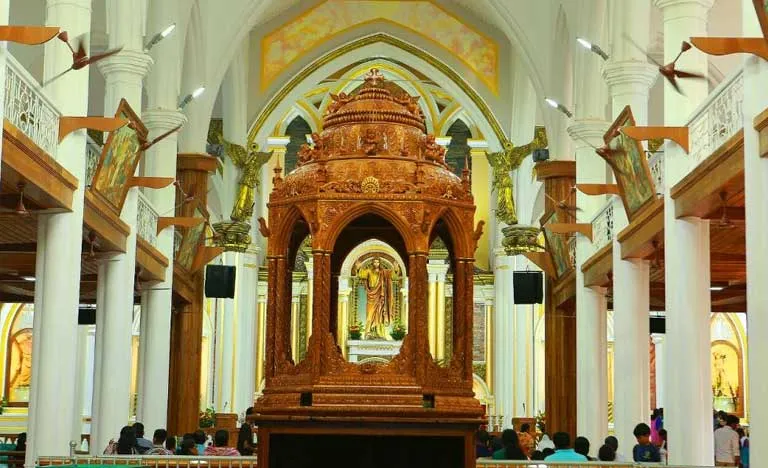
Mass Time
Weekdays
Sundays
Fridays
Church Visiting Time
Attractions Nearby
- Kumarakom Bird Sanctuary,
- Vembanad Lake
- Pathiramanal Island
- Marari Beach
- Alappuzha Beach
- Kerala Kayaking
- Kumarakom Beach
- Bay Island Driftwood Museum
- Revi Karunakaran Museum
Other Facilities
St Francis Assisi Higher Secondary School, Arthunkal has celebrated its centenary in 2004. There is also a Regional Fisheries Technical High School, Teachers Training Institute, Industrial Training Institute, Nursing College, Primary Health Centre, Jose Medical Store and Saint Sebastian’s Visitation Hospital.
Other institutions in Arthunkal are Post Office, State Bank of India, Arthunkal Co Operative Bank, Police station, Yuva Swapna Retreat centre.
Contact Info
Church Road, Arthunkal P.O, Cherthala,
Alappuzha, Kerala – 688 530, India
Phone No.
Tel : 0478 – 257 3560, 257 2374, +91 9744663560 (Rector)
Accommodations
Connectivity
St. Andrew’s Basilica Arthunkal, Alleppey, Kerala, India is well connected with Bus Station, Railway Station and Airport facilities rest of the country.
Airways
Cochin International Airport, Kerala which is (65 Kms) from St. Andrew’s Basilica Arthunkal, Alleppey, Kerala, India.
Railways
The nearest railway station is Cherthala Railway Station which is (7.5 Kms) and Alappuzha (20.5 Kms) from St. Andrew’s Basilica Arthunkal, Alleppey, Kerala, India.
Roadways
The nearest is Cherthala Bus Stand which is (7.1 Kms) Alappuzha Bus Station (22.2 Kms) from St. Andrew’s Basilica Arthunkal, Alleppey, Kerala, India.

